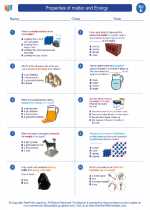Properties of matter and Energy -> biogas
How is Biogas Produced?
Biogas is produced through the process of anaerobic digestion, which occurs in a sealed container called a digester. During anaerobic digestion, microorganisms break down organic matter, releasing biogas as a byproduct. The process involves the following steps:- Feedstock Preparation: Organic waste materials such as food scraps, manure, and agricultural residues are collected and prepared for digestion.
- Anaerobic Digestion: The prepared organic matter is placed in a sealed digester, where bacteria break down the material in the absence of oxygen, producing biogas.
- Biogas Collection: The biogas produced is collected and stored for use as a renewable energy source.
- Residue Management: The leftover material, known as digestate, can be used as a nutrient-rich fertilizer for crops.
Uses of Biogas
Biogas has a variety of uses, including:- Cooking: Biogas can be used as a clean-burning fuel for cooking and heating, providing an alternative to traditional cooking methods that rely on wood or charcoal.
- Electricity Generation: Biogas can be used in generators to produce electricity for homes, farms, and businesses.
- Heating: Biogas can be used to provide heat for buildings, greenhouses, and other facilities.
- Vehicle Fuel: Biogas can be processed and used as a renewable fuel for vehicles, reducing reliance on fossil fuels.
Environmental Benefits
Biogas offers several environmental benefits, including:- Reduction of Greenhouse Gas Emissions: By capturing methane from organic waste, biogas production helps reduce the release of methane, a potent greenhouse gas, into the atmosphere.
- Waste Management: Biogas production provides a sustainable way to manage organic waste, diverting it from landfills and reducing the release of harmful methane emissions from decomposing waste.
- Renewable Energy Source: Biogas is a renewable energy source that can help reduce reliance on non-renewable fossil fuels.
Study Guide: Biogas
Key Concepts:
- What is biogas?
- How is biogas produced through anaerobic digestion?
- What are the primary components of biogas?
- What are the uses of biogas?
- What environmental benefits does biogas offer?
Review Questions:
- Describe the process of anaerobic digestion and how it produces biogas.
- What are some common sources of organic waste used in biogas production?
- Explain how biogas can be used as a renewable energy source for cooking and heating.
- What role does biogas play in reducing greenhouse gas emissions and managing organic waste?
◂Science Worksheets and Study Guides Fifth Grade. Properties of matter and Energy
Study Guide Properties of matter and Energy
Properties of matter and Energy  Worksheet/Answer key
Worksheet/Answer key Properties of matter and Energy
Properties of matter and Energy  Worksheet/Answer key
Worksheet/Answer key Properties of matter and Energy
Properties of matter and Energy  Worksheet/Answer key
Worksheet/Answer key Properties of matter and Energy
Properties of matter and Energy  Vocabulary/Answer key
Vocabulary/Answer key Properties of matter and Energy
Properties of matter and Energy  Vocabulary/Answer key
Vocabulary/Answer key Properties of matter and Energy
Properties of matter and Energy 

 Worksheet/Answer key
Worksheet/Answer key
 Worksheet/Answer key
Worksheet/Answer key
 Worksheet/Answer key
Worksheet/Answer key
 Vocabulary/Answer key
Vocabulary/Answer key
 Vocabulary/Answer key
Vocabulary/Answer key

The resources above cover the following skills:
PHYSICAL SCIENCE (NGSS)
Matter and Its Interactions
Students who demonstrate understanding can:
Develop a model to describe that matter is made of particles too small to be seen.